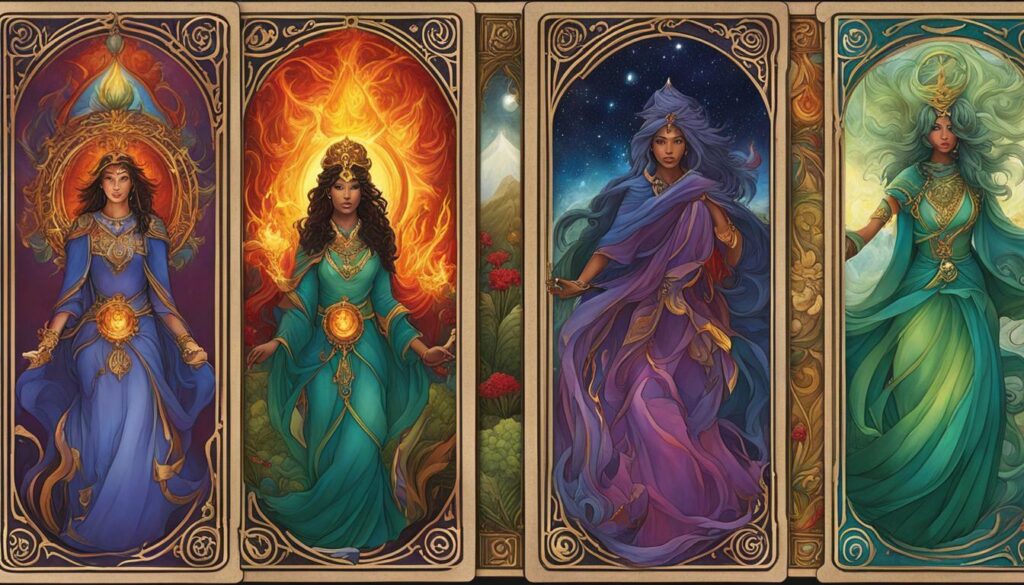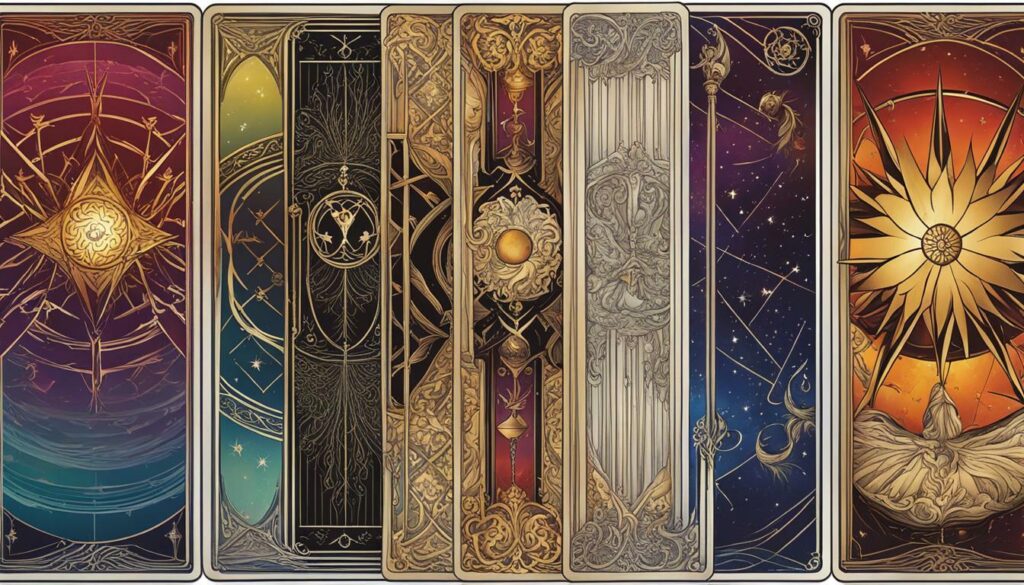When it comes to tarot card readings, one of the essential elements is the use of vibrant colors that make up the cards. Colors are a crucial aspect of tarot, representing different meanings and energies. Tarot experts believe that the colors used in tarot cards are indicative of the four classical elements – fire, water, air, and earth, which are also associated with the universal energy. In this section, we will explore how color and elements are related to tarot and their significance in interpreting tarot cards.
Key Takeaways:
- Tarot cards utilize a variety of colors that hold specific meanings
- Colors in tarot are related to the four classical elements and universal energy
- Understanding the significance of color in tarot can enhance the interpretation of tarot cards
Understanding the Four Elements in Tarot
In tarot, the four elements – fire, water, air, and earth – hold significant symbolism and meaning. Each element corresponds to a specific aspect of life and consciousness. Fire represents passion and transformation, water represents emotion and intuition, air represents intellect and communication, and earth represents stability and material abundance.
These elements are also present in the tarot deck, with each suit corresponding to one of the elements. Wands (or rods) represent fire, cups represent water, swords represent air, and pentacles (or coins) represent earth. Understanding the symbolism of the four elements in tarot can provide deeper insights into the cards and their meanings.
Moreover, the colors present in each card can further emphasize the elements and their meanings. For example, the Ace of Swords – representing air – is often depicted with shades of blue and white, emphasizing the intellectual and communicative aspects of the element.

By understanding the symbolism of the four elements and their corresponding colors in tarot, we can gain a deeper appreciation for the complexities and nuances of the tarot deck.
The Influence of Color on Tarot Card Meanings
Color plays an essential role in interpreting tarot cards. Different colors can evoke specific emotions and energies, contributing to the overall interpretation of the card. This is why it is crucial to understand the symbolism of colors in tarot.
For instance, red represents passion, strength, and fire, while blue represents calmness, intuition, and water. Yellow is associated with happiness, energy, and the sun, while green is associated with growth, harmony, and the earth.
When interpreting tarot cards, the colors present in the card can provide clues to the card’s meaning. For example, if a tarot card has a lot of red, it could indicate a passionate or intense energy is present. In contrast, a card with a lot of blue could indicate a need for calmness and introspection.
Additionally, the color of the surrounding cards can also influence the interpretation of the card. If a card with a predominantly red hue is surrounded by blue cards, it could indicate the need for balance between passion and calmness.
It is important to note that color symbolism in tarot is not set in stone. The interpretation can vary depending on the reader, the deck, and the context of the question asked.
Overall, understanding the symbolism of colors in tarot can significantly enhance the interpretation of tarot cards. By paying attention to the colors present in the card and their meanings, we can gain deeper insights into the message the card is trying to convey.

“Colors, like features, follow the changes of the emotions.” – Pablo Picasso
Unveiling the Tarot Color Psychology
Colors have a profound impact on our emotions and behavior. The study of this phenomenon is known as color psychology, and it is a crucial aspect of tarot interpretation. Understanding the psychological significance of different colors can help us gain deeper insights into the meanings of tarot cards.
Tarot color psychology explores the connections between color, symbolism, and the human psyche.
In tarot, colors are used to evoke specific emotions and energies. For instance, the color red is associated with passion, strength, and courage, while blue symbolizes calmness, serenity, and clarity of thought. Yellow, on the other hand, represents joy, optimism, and creativity, and green is connected to growth, prosperity, and healing.
| Color | Meaning |
|---|---|
| Red | Passion, strength, courage |
| Blue | Calmness, serenity, clarity of thought |
| Yellow | Joy, optimism, creativity |
| Green | Growth, prosperity, healing |

Moreover, colors can also evoke specific psychological responses. For example, warm colors like red and orange can stimulate the senses and increase energy levels, while cool colors such as blue and green can have a calming effect and reduce anxiety and stress.
By understanding the psychological influence of color, we can gain greater insight into the meanings of tarot cards.
In tarot, the psychological significance of color can be seen in the way different colors are used to represent the four elements – fire, water, air, and earth. Each element has its own color associations, and understanding these can provide additional layers of meaning to tarot readings.
Next, we will explore how color and element correspondences are used in tarot card interpretation.
Analyzing Tarot Cards through Color and Element Correspondence
Now that we understand the symbolism of color and the four elements in tarot, we can begin to analyze specific tarot cards using this knowledge. By exploring the colors and elements present in a card, we can gain deeper insights into its meaning and symbolism.
Let’s take the Ace of Cups as an example. This card is associated with the element of water, which is often represented by shades of blue. The cup itself is typically depicted as overflowing with water, symbolizing abundance and emotional fulfillment.
| Element | Color | Suit |
|---|---|---|
| Fire | Red, orange, yellow | Wands |
| Water | Blue, teal, aqua | Cups |
| Air | Yellow, white, gray | Swords |
| Earth | Green, brown, black | Pentacles |
Similarly, the Three of Wands is associated with the element of fire, which is often represented by shades of red, orange, and yellow. The three wands in the card symbolize growth and expansion, and the fiery colors represent passion and creativity.
When analyzing tarot cards through color and element correspondence, it’s important to consider the overall energy and symbolism of the card. For example, the color red may represent passion and energy in some cards, but it may also represent danger or warning in others.
By combining our understanding of color and element symbolism with our knowledge of individual tarot cards, we can gain a deeper understanding of the messages and insights they hold. This can enhance our tarot readings and provide greater clarity and guidance.

Conclusion
Throughout this article, we have explored the relationship between color, elements, and universal energy in tarot. We have discussed the significance of color in interpreting tarot cards, and how the four elements – fire, water, air, and earth – are represented through color and their corresponding meanings in the tarot deck.
We have also delved into the psychological aspects of color in tarot, and how different colors can evoke certain psychological responses that can enhance the interpretation of tarot cards. By analyzing tarot cards through color and element correspondence, we can gain deeper insights into their meanings and offer more accurate readings to our clients.
Understanding the connection between color, elements, and universal energy in tarot is crucial for any tarot reader, as it can significantly enhance their readings and offer a more profound understanding of the symbolism present in the tarot deck. By utilizing this knowledge, we can provide more insightful and comprehensive readings for our clients, and offer them guidance and clarity when they need it the most.
Therefore, we encourage all tarot enthusiasts and readers to continue exploring the significance of color and elements in tarot and how it can enhance their practice. It is through this exploration and experimentation that we can uncover new insights and offer more profound guidance to those who seek it.
FAQ
Q: Is color related to the four elements and the universal energy in tarot?
A: Yes, color is closely connected to the four elements – fire, water, air, and earth – as well as the universal energy in tarot. The colors used in tarot cards carry symbolic meanings that correspond to these elements and help interpret the cards.
Q: How do the four elements influence tarot card meanings?
A: The four elements – fire, water, air, and earth – provide a framework for understanding the symbolism and meanings of tarot cards. Each element has its own associated colors and energies, which contribute to the interpretation of the cards and the messages they convey.
Q: What role does color play in tarot card interpretation?
A: Color plays a significant role in tarot card interpretation. Different colors evoke specific emotions and energies, which can enhance or alter the meaning of a card. Understanding the symbolism of color in tarot can provide valuable insights into the messages conveyed by the cards.
Q: How does tarot color psychology influence card readings?
A: Tarot color psychology examines the psychological responses and associations we have with different colors. By understanding the psychological aspects of color, readers can gain a deeper understanding of the cards and their impact on the querent’s subconscious mind.
Q: How can I analyze tarot cards using color and element correspondence?
A: To analyze tarot cards using color and element correspondence, pay attention to the colors present in the card’s imagery and consider how they relate to the four elements. This analysis will provide insights into the card’s meaning, allowing for a more nuanced interpretation.

